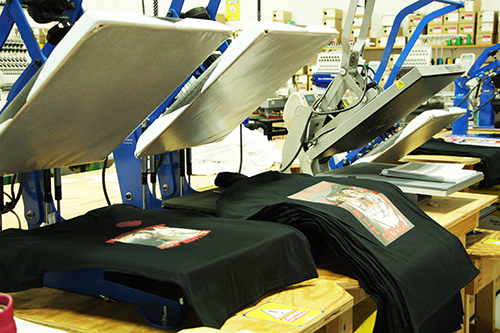
If you have been researching custom t-shirts, you may have seen the terms “screen printing” and “digital printing” pop up before. These are the two most common methods of printing custom apparel.
Although embroidery is also offered as an option to decorate t-shirts, we recommend screen or digital printing your design or logo on any type of t-shirts. As Canada's industry leader for custom printed t-shirts, we are often asked whether screen-printing is better than digital printing or vice versa.
The real answer is that there is not a more superior choice between the two types of printing processes. What it boils down to is understanding your needs and figuring out which method will work better for the design, colour and fabric material of the shirts you have chosen to decorate. Here's a quick look at the differences between the two printing methods so that you can decide for yourself which type of printing you should go for.
Digital Printing
Digital printing is a much newer method of printing custom apparel and is commonly known as direct-to-garment printing. Rather than applying one layer or colour at a time using screens, a direct-to-garment printer will apply all colours directly to the garment in one single layer of ink. Think of this process like when you watch a regular paper printer output a photo at home. The printer applies all the necessary colours in a single pass, from top to bottom, and eventually produces a full image once the paper comes out. The ink used is for this type of printing is a lightweight water-based ink that absorbs easily into the garment fibers without a mess.

Two major pros of this decoration method are:
Design Possibilities Are Limitless
With ink being applied directly to the garment, you have more room to be creative with your custom t-shirt design. Highly detailed or elaborate designs can be executed flawlessly using this printing method.
Photo Ready!
Another great pro of digital printing is the ability to print live images. Whether it’s a photo of a loved one, fresh food, animals, or anything else in between, printing direct-to-garment allows you to rock realistic images on your custom gear.
Easier Execution for Small Orders
With minimal set up and no screens required, digital printing is great for executing orders of smaller quantities.
As with any other decoration method, there are some drawbacks:
T-Shirt Material Limitations
Due to the way digital print ink adheres to garments, 100% cotton material typically works best for this printing method. Any other fabric or fabric blend may produce lower quality results.
Use DTG for small events, personalized gifts, and creative projects.
Screen Printing
Since its introduction back in 1907, screen printing has been the most commonly used printing method for custom T-shirts. Another common name for screen printing is silkscreen printing. In the start of this process, the artwork is first burned into the mesh screens. This creates a stencil of your artwork which will then be placed directly over your garment of choice. Next, you the screens are loaded to a printing machine and ink is added to be wiped over the “stencil”. For every colour in the artwork, a different screen is created. Each layer of colour is printed in separate runs. The last step is to let the inks on the t-shirt dry.

Here are all the benefits of screen printing:
Economies of Scale
The more t-shirts you print, the lesser the cost. Since the process is highly automated, once you hit quantities of 12 pieces or more, there is less work involved in the production of each custom t-shirt.
Simple and bold
Simple designs are printed with ease given the clean method of applying ink over each screen, resulting in high quality prints. This printing method also tends to allow a larger printing space depending on the size of the screens.
Here are some cons of screen printing:
Higher Quantities
Since there is a lot of work involved in burning and preparing screens, a minimum order quantity is often stipulated on screen prints.
Multi-Colours and Photo Print Limitations
With screen printing, every layer of colour is added on individually using its own screen. When designs have multiple colours, it can become very costly to create screens and run each t-shirt through the machine multiple times, for each layer of colour. Furthermore, photo realistic prints become nearly impossible to print with shading and gradient effects involved.
Use screen printing for large events and team or staff uniforms.
Now that you know the difference between the two printing methods, you will be able to make a more informed choice when selecting the print type for your custom t-shirts. Regardless which type you choose, the team here at Entripy.com will be happy to help you customize your T-shirts in Canada with your preferred printing method.
Contact our Client Experience Team, 7 days a week, for help with your custom apparel at clientcare@entripy.com or 1-866-368-7479.







